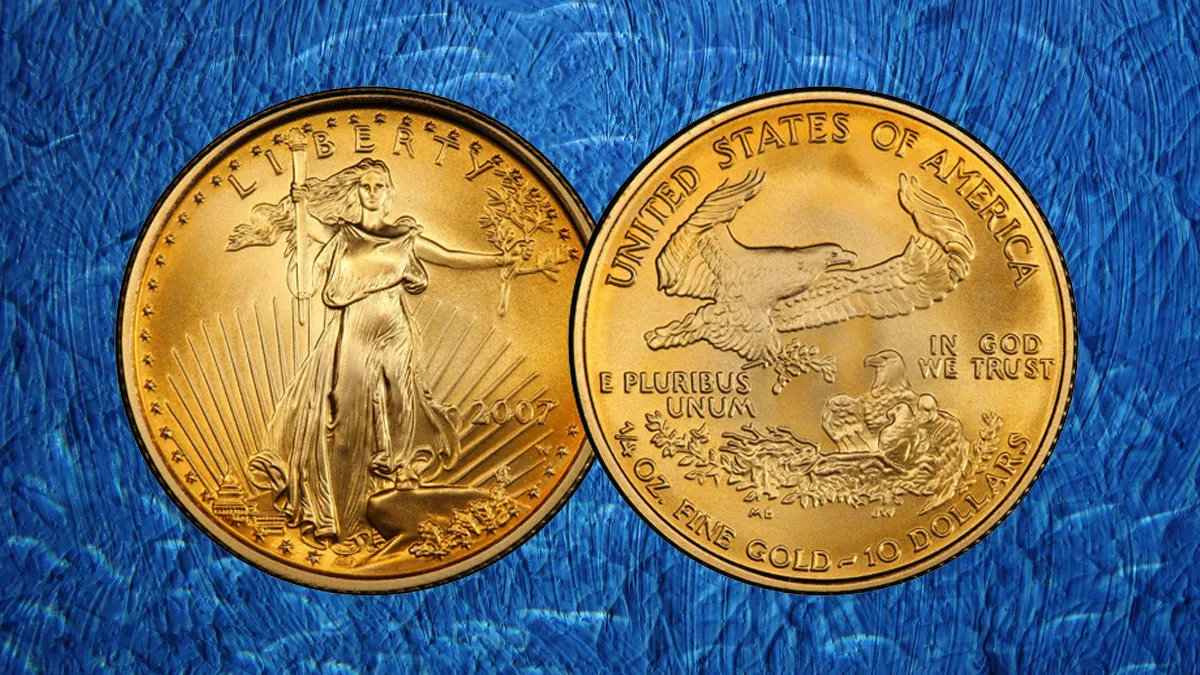
The American Gold Eagle Coin is unique among official gold bullion coins of the United States because these coins must have been made by gold mined, a unique exception was made in that Gold Eagles, with 91.67% purity (22 karats), are the only gold bullion coins with less than 99.9% purity that are considered IRA-eligible. Normally, only 24-karat gold coins (0.999 millesimal fineness) allow for a Precious Metals IRA and it is the first bullion coin whose design was made by a woman.
Authorized by the Gold Bullion Act of 1985, the U.S. Mint released the first American Gold Eagle coin in 1986 to compete with popular foreign coins.
American Gold Eagle History
American Eagle Gold Proof Coins are collector versions of U.S. Mint bullion coins, available in four sizes since 1986. They have 91.67% (22-karat) gold and are minted at the West Point facility with a “W” mint mark. The obverse features Liberty, inspired by the 1907 “Double Eagle” design by Saint-Gaudens. In 2021, the Mint updated the design using historical assets.
The reverse, updated since 2021, shows an eagle portrait with enhanced security features, including a reeded edge. Previously, from 1986-2021, the reverse showed an eagle with an olive branch above a nest. In 2020, a special coin commemorating the 75th Anniversary of the End of World War II was produced with a “V75” privy mark shaped like the Rainbow Pool at the WWII Memorial in Washington, DC.
10 Rare American Gold Eagle Bullion Coins
1. 2007-W $10 Burnished Gold Eagle (Special strike)
The 2007-W $10 Burnished Gold Eagle is a special strike coin minted at West Point. It has a diameter of 22.00 millimeters and weighs 8.48 grams. The coin is made of 91.67% gold, 3% silver, and 5.33% copper. Designed by Augustus Saint Gaudens and Miley Busiek, it features a reeded edge. With a mintage of 12,766, its highest auction record is $1,042 for an MS70 grade on August 5, 2012, at Great Collections.
2. 2006-W $25 Burnished Gold Eagle (Special strike)
The 2006-W $25 Burnished Gold Eagle is a special strike coin from West Point. It has a diameter of 27.00 millimeters and weighs 16.97 grams. Composed of 91.67% gold, 3% silver, and 5.33% copper, the coin features a reeded edge. Designed by Augustus Saint Gaudens and Miley Busiek, it has a mintage of 15,164. Its highest auction record is $1,900 for an MS69 grade on March 31, 2010, on eBay.
3. 2005-W $5 Gold Eagle, DCAM (Proof)
The 2005-W $5 Gold Eagle is a Proof coin from West Point with a PCGS PR70DCAM grade. It has a diameter of 16.50 millimeters and weighs 3.39 grams. Composed of 91.67% gold, 3% silver, and 5.33% copper, the coin features a reeded edge. Designed by Augustus Saint Gaudens and Miley Busiek, it has a mintage of 49,265. Its highest auction record is $2,640 for a PR70DC grade on January 3, 2018, at Heritage Auctions.
4. 2004-W $5 Gold Eagle, DCAM (Proof)
The 2004-W $5 Gold Eagle is a Proof coin from West Point with a PCGS PR70DCAM grade. It has a diameter of 16.50 millimeters and weighs 3.39 grams. The coin is made of 91.67% gold, 3% silver, and 5.33% copper, featuring a reeded edge. Designed by Augustus Saint Gaudens and Miley Busiek, it has a mintage of 35,131. Its highest auction record is $1,725 for a PR69 grade on April 26, 2006, at Heritage Auctions.
5. 2003 $50 Gold Eagle (Regular Strike)
The 2003-W $50 Gold Eagle is a Proof coin from West Point with a PCGS PR70DCAM grade. It has a diameter of 32.70 millimeters and weighs 33.93 grams. Composed of 91.67% gold, 3% silver, and 5.33% copper, the coin features a reeded edge. Designed by Augustus Saint Gaudens and Miley Busiek, it has a mintage of 28,344. Its highest auction record is $3,410 for a PR70 grade on October 14, 2012, at Great Collections.
6. 2005 $5 Gold Eagle (Regular Strike)
The 2005 $5 Gold Eagle is a regular strike coin from Philadelphia, graded PCGS MS70. It has a diameter of 16.50 millimeters and weighs 3.39 grams. Made of 91.67% gold, 3% silver, and 5.33% copper, the coin features a reeded edge. Designed by Augustus Saint Gaudens and Miley Busiek, it has a mintage of 300,043. Its highest auction record is $1,955 for an MS69 grade on February 24, 2008, at Heritage Auctions.
7. 2021 $50 Gold Eagle – Type 1 (Regular Strike)
The 2021 $50 Gold Eagle – Type 1 is a regular strike coin, graded PCGS MS70. It has a diameter of 32.70 millimeters, but the weight, mintage, and mint are not specified. Made of 91.67% gold, 3% silver, and 5.33% copper, it has an unknown designer and edge type. The highest auction record for this coin is $2,100 for an MS70 grade on May 1, 2022, at David Lawrence RC.
8. 2022 $50 Gold Eagle First Day of Issue (Regular Strike)
The 2022 $50 Gold Eagle First Day of Issue is a regular strike coin, graded PCGS MS70. It has a diameter of 32.70 millimeters, weighs 33.93 grams, and is made of 91.67% gold, 3% silver, and 5.33% copper. The designer, edge type, mintage, mint, and auction record are not specified.
9. 2021 $50 Gold Eagle – Type 2 (Regular Strike)
The 2021 $50 Gold Eagle – Type 2 is a regular strike coin with a PCGS MS70 grade. It has a diameter of 32.70 millimeters and is made of 91.67% gold, 3% silver, and 5.33% copper. It sold for $2,101 at auction on 05-01-2022 with David Lawrence RC.
10. 2006-W $50 Eagle-20th Anniv. Rev PR (Proof)
The 2006-W $50 Eagle, part of the 20th Anniversary Reverse Proof series, is a proof coin with a PCGS PR70 grade. It has a diameter of 32.70 millimeters and weighs 33.93 grams. Produced at West Point, the coin has a mintage of 9,996 and is made of 91.67% gold, 3% silver, and 5.33% copper. It achieved an auction record of $9,200 on 09-07-2011 with Heritage Auctions.
Purity, Weight, Sizes, and Content of the Gold Eagle
IRA-eligible American Gold Eagle bullion coin’s purity, weight, and content are certified by the U.S. government and backed by the U.S. Mint. Each Gold Eagle coin has one troy ounce of .9167 pure gold with an alloy of 3% silver and 5.33% copper to improve its wear-resistant durability.
This is equivalent to 22 karats, the standard for English crown gold coins and American gold coins minted before 1834.
The legislation authorized the Treasury to strike four gold coins: one ounce, 1/2 ounce, 1/4 ounce, and 1/10 ounce. Their face values are US$50, US$25, US$10, and US$5, respectively.
The bullion values of these coins usually surpass their face values. Their value is tied to the metal content, not their denomination, unlike collectible coins which can have added value. American Gold Eagle Coins, with lower gold content, generally have a lower premium over the gold spot price compared to other IRA-approved coins.
- A 1 oz. American Gold Eagle is 32.7 mm in diameter and 2.87 mm thick.
- A 1/2 oz. is 27 mm in diameter and 2.15 mm thick.
- A 1/4 oz. is 22 mm in diameter and 1.78 mm thick.
- A 1/10 oz. is 16.5 mm in diameter and 1.26 mm thick.
American Gold Eagle Coin Mintage Figures
The U.S. Mint produces American Gold Eagle coins based on investor demand, guiding to varying mintage figures each year. The 1986 release established high mintage records that stayed until the Y2K scare:
1986:
1 oz Gold Eagle – 1.362 million coins
1/2 oz Gold Eagle – 599,000 coins
1/4 oz Gold Eagle – 726,000 coins
1/10 oz Gold Eagle – 912,000 coins
Originally, the 1 oz coin was the most popular. However, lower denominations achieved favor as gold prices extended in the 21st century. Economic factors also impact design popularity and mintage. The 1 oz and 1/10 oz coins established records in 1998 and 1999:
1998:
1 oz Gold Eagle – 1.468 million coins
1/10 oz Gold Eagle – 1.344 million coins
1999:
1 oz Gold Eagle – 1.505 million coins
1/10 oz Gold Eagle – 2.75 million coins
Design of the American Gold Eagle Coin
The obverse design of the American Gold Eagle is motivated by the Saint-Gaudens’ Double Eagle, featuring a front-facing Lady Liberty stepping on a mountaintop with the sun’s rays behind her. She has a torch for enlightenment and an olive branch for peace.
The word “Liberty” is inscribed at the top in capital letters, with the U.S. Capitol image at the bottom. The mint year is within the sun’s rays at the bottom right, utilizing Roman numerals from 1986-1991 and Arabic numerals from 1992 onwards. Fifty stars cover the design, representing the fifty states.
The reverse design by Miley Busiek depicts a family of eagles, representing America as a caring family. The male eagle, carrying an olive branch, drops towards its nest with its mate and hatchlings. T
his “Family of Eagles” design seems on the one-ounce coin, with the Treasury extending it to the fractional coins. “United States of America” is at the top, with the coin’s gold content and face value at the bottom. “E Pluribus Unum” is below the flying eagle, and “In God We Trust” is beside the mother eagle.
Rare Gold Coins Investment
Investing in rare coins can offer substantial profit beyond their metal value. Elite coins have appreciated over 1,000% from 1976-1980 and 600% from 1982-1989, according to Finest Known. While not a replacement for traditional investments, rare coins can diversify and reduce risk in your portfolio.
The rare coin market has evolved, with third-party grading services introduced in the 1980s, reducing investment risks. Online resources have also expanded knowledge on coin collecting and buying.
For beginners, seek guidance from a mentor for coin value research and future potential. Attend coin shows, read books, consult with dealers, and join coin clubs to learn more.
Gold Eagle Coin Grading Guide
Coin collectors value coins with a clean finish, clear designs, and inscriptions. Grading, or assessing a coin’s condition, decreases subjectivity and is certified by grading companies like PCGS, NGC, ICG, and ANACS. These companies seal graded coins in scratch-resistant casings.
Grading uses a 1 to 70 scale, where 70 is perfect and 1 is barely recognizable. Terms like Poor (PO), Fair (FR), Good (G), Very Good (VG), Fine (F), Very Fine (VF), Extremely Fine (XF, EF), About Uncirculated (AU), and Mint State (MS) describe grades. The upper scale (60-70) represents uncirculated coins, with 70 being flawless.
Authenticating Rare Gold Coins
Gold has a density of 19.3 grams per cc, while water has a density of 1 gram per cc. To determine a gold coin’s purity, weigh the coin, pour 1 cc of water into a graduated cylinder, and measure the water displacement when the coin is added. Use ratio and proportion to find the purity. This method was used by Archimedes to expose a goldsmith cheating the king of Syracuse. Quite bold!
Also Read – Top 10 American Silver Eagle Bullion Coins
Conclusion:
The American Gold Eagle coin is a unique and valuable addition because of its rare design, its high purity of 91.67% gold, and its historical significance. It offers both financial value and visual interest. The coin’s attraction to investors is further boosted by the simple fact that it can be added to Precious Metals IRAs.
Many regular striking and special edition coins have been minted over the years; each has its own mintage information, designs, and auction records. The American Gold Eagle coin is a desired item for many people, regardless of their level of expertise in collection or investing. It contains history, artistry, and the future returns.
